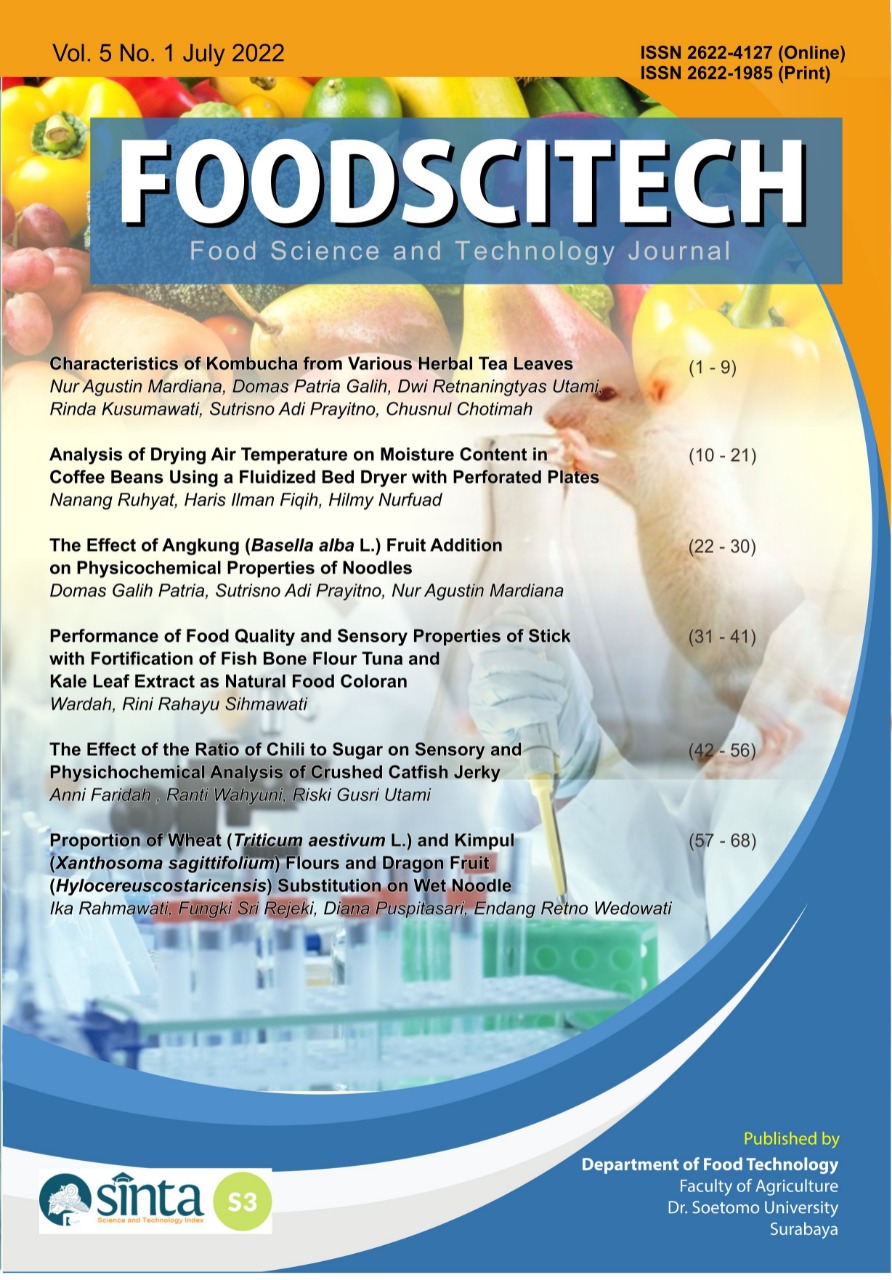Main Article Content
Abstract
Kombucha has been well-known as functional food in Asia. Regular kombucha is produced using Camellia sinensis tea leaves. However, kombucha can also be produced from other substrates. This study aim to investigated characteristic of kombucha from various herbal tea by determine flavonoid content, phenolic content, antioxidant content and sensory. This study was conducted using Randomized Block Design with one factor and two duplicates of each treatment. Based on 8 day fermentation, bebuas (Premna pubescens Blume) has the highest phenolic content (926,19 µg/ml GAE), flavonoid content (391,81 µg/ml), and antioxidant activity IC50 values were 18,16 µg/ml. On the other hand, based on the sensory evaluation of kombucha (aroma and taste) panelists prefer indian jujube, while panelists prefer regular tea for color parameters
Keywords
Article Details

This work is licensed under a Creative Commons Attribution-NonCommercial-ShareAlike 4.0 International License.

This work is licensed under a Creative Commons Attribution-ShareAlike 4.0 International License.
References
- Balitbangkes. (2018). Laporan Nasional Riskesdas 2018. In Badan Penelitian dan Pengembangan Kesehatan (p. 198). Lembaga Penerbit Badan Penelitian dan Pengembangan Kesehatan. http://labdata.litbang.kemkes.go.id/images/download/laporan/RKD/2018/Laporan_Nasional_RKD2018_FINAL.pdf
- Christiani Dwiputri, M., & Lauda Feroniasanti, Y. M. (2019). Effect of fermentation to total titrable acids, flavonoid and antioxidant activity of butterfly pea kombucha. Journal of Physics: Conference Series, 1241(1). https://doi.org/10.1088/1742-6596/1241/1/012014
- Daud, D., Dewa, M. S. A. M., Mahbob, E. N. M., & Razak, W. R. W. A. (2021). Short communication: Phytochemical diversity and bioactivity of Malaysian premna cordifolia (lamiaceae). Biodiversitas, 22(6), 3245–3248. https://doi.org/10.13057/biodiv/d220628
- Jakubczyk, K., Kałduńska, J., Kochman, J., & Janda, K. (2020). Chemical profile and antioxidant activity of the kombucha beverage derived from white, green, black and red tea. Antioxidants, 9(5). https://doi.org/10.3390/antiox9050447
- Mardiana, N. A., Patria Galih, D., Adi Prayitno, S., & Chotimah, C. (2021). Physicochemical Properties And Sensory Evaluation Of Fermented Mustard With Difference Ratio Of Rice Water And Tal Palm Sap. Kontribusia : Research Dissemination for Community Development, 5(1), 15. https://doi.org/10.30587/kontribusia.v5i1.2930
- Muñoz, R., de las Rivas, B., López de Felipe, F., Reverón, I., SantamarÃa, L., Esteban-Torres, M., Curiel, J. A., RodrÃguez, H., & Landete, J. M. (2017). Biotransformation of Phenolics by Lactobacillus plantarum in Fermented Foods. In Fermented Foods in Health and Disease Prevention. Elsevier Inc. https://doi.org/10.1016/B978-0-12-802309-9.00004-2
- Neffe-Skocińska, K., Sionek, B., Ścibisz, I., & Kołożyn-Krajewska, D. (2017). Acid contents and the effect of fermentation condition of Kombucha tea beverages on physicochemical, microbiological and sensory properties. CYTA - Journal of Food, 15(4), 601–607. https://doi.org/10.1080/19476337.2017.1321588
- Nurikasari, M., Puspitasari, Y., & Siwi, R. P. Y. (2017). Characterization And Analysis Kombucha Tea Antioxidant Activity Based On Long Fermentation As A Beverage Functional. Journal of Global Research in Public Health, 2(2), 90–96.
- Pereira, D. M., Valentão, P., Pereira, J. A., & Andrade, P. B. (2009). Phenolics: From chemistry to biology. Molecules, 14(6), 2202–2211. https://doi.org/10.3390/molecules14062202
- Pratama, N., Pato, U., & Yusmarini, Y. (2015). Kajian Pembuatan Teh Kombucha dari Kulit Buah Manggis (Garcinia Mangostana L.). Jurnal Online Mahasiswa Fakultas Pertanian Universitas Riau, 2(2), 1–12.
- Rivero-Cruz, J. F., Granados-Pineda, J., Pedraza-Chaverri, J., Pérez-Rojas, J. M., Kumar-Passari, A., Diaz-Ruiz, G., & Rivero-Cruz, B. E. (2020). Phytochemical constituents, antioxidant, cytotoxic, and antimicrobial activities of the ethanolic extract of mexican brown propolis. Antioxidants, 9(1), 1–11. https://doi.org/10.3390/antiox9010070
- Ruwali, P., Negi, D., & Pushpa Ruwali, C. (2019). Phytochemical analysis and evaluation of antioxidant activity of Premna latifolia Roxb. A medicinal plant (Family: Lamiaceae). ~ 13 ~ The Pharma Innovation Journal, 8(5), 13–20. www.thepharmajournal.com
- Selma, M. V., EspÃn, J. C., & Tomás-Barberán, F. A. (2009). Interaction between Phenolics and Gut Microbiota: Role in Human Health. Journal of Agricultural and Food Chemistry, 57(15), 6485–6501. https://doi.org/10.1021/JF902107D
- Shukri, M. A. M., Alan, C., & Site Noorzuraini, A. R. (2011). Polyphenols and antioxidant activities of selected traditional vegetables (Polifenol dan aktiviti antioksida ulam-ulam terpilih). J. Trop. Agric. and Fd. Sc, 39(1), 69–83.
- Song, B., Xu, H., Chen, L., Fan, X., Jing, Z., Chen, S., & Xu, Z. (2020). Study of the Relationship between Leaf Color Formation and Anthocyanin Metabolism among Different Purple Pakchoi Lines. Molecules, 25(20). https://doi.org/10.3390/MOLECULES25204809
- Suhardini, P. N., & Zubaidah, E. (2016). Studi Aktivitas Antioksidan Kombucha Dari Berbagai Jenis Daun Selama Fermentasi. Jurnal Pangan Dan Agroindustri, 4(1), 221–229.
- Umamaheswari, & Chatterjee. (2007). In vitro antioxidant activities of the fractions of Coccinia grandis L. leaf extract. African Journal of Traditional, Complementary, and Alternative Medicines : AJTCAM, 5(1). https://doi.org/10.4314/ajtcam.v5i1.31258
- Uppin, J. B., Chandrasekhar, V. M., & Naik, R. (2017). Total phenolic compound and antioxidant properties of Premna integrifolia Leaf Extracts from Northern Karnataka. 2(6).
- Villarreal-Soto, S. A., Beaufort, S., Bouajila, J., Souchard, J. P., & Taillandier, P. (2018). Understanding Kombucha Tea Fermentation: A Review. Journal of Food Science, 83(3), 580–588. https://doi.org/10.1111/1750-3841.14068
- Vohra, B., Fazry, S., Sairi, F., & Othman, B. A. (2019). Effects of medium variation and fermentation time towards the pH level and ethanol content of Kombucha. AIP Conference Proceedings, 2111(1998), 298–302. https://doi.org/10.1063/1.5111247
- Zhang, W., Zhang, L., & Xu, C. (2016). Chemical and volatile composition of jujube wines fermented by Saccharomyces cerevisiae with and without pulp contact and protease treatment. Food Science and Technology, 36(2), 204–209. https://doi.org/10.1590/1678-457X.0011
- Zofia, N. Å., Aleksandra, Z., Tomasz, B., Martyna, Z. D., Magdalena, Z., Zofia, H. B., & Tomasz, W. (2020). Effect of fermentation time on antioxidant and anti-ageing properties of green coffee kombucha ferments. Molecules, 25(22). https://doi.org/10.3390/molecules25225394
- Zubaidah, E., Yurista, S., & Rahmadani, N. R. (2018). Characteristic of physical, chemical, and microbiological kombucha from various varieties of apples. IOP Conference Series: Earth and Environmental Science, 131(1). https://doi.org/10.1088/1755-1315/131/1/012040
